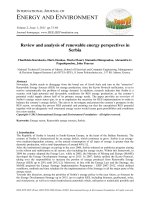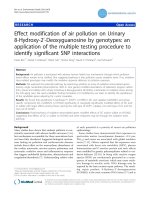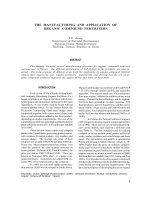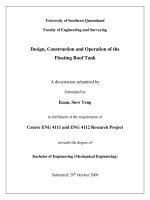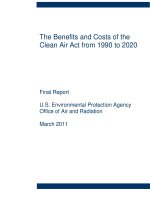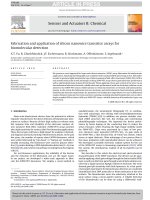REVIEW AND APPLICATION OF THE TULSA LIQUID JET PUMP MODEL
Bạn đang xem bản rút gọn của tài liệu. Xem và tải ngay bản đầy đủ của tài liệu tại đây (1.57 MB, 75 trang )
REVIEW AND APPLICATION OF THE
TULSA LIQUID JET PUMP MODEL
Pål Jåtun Pedersen
Trondheim
December 2006
Review and Application of the Tulsa Liquid Jet Pump Model
December 2006
Preface
This report is a mandatory project assignment in the 9th semester of the petroleum production
engineering studies at NTNU. It was written at the institute for petroleum technology and
applied geophysics, fall 2006. The assignment consists of 71 pages, and was delivered the 19th
of December 2006.
I would like to thank Professor Jón Steinar Guðmundsson for good help and advice
throughout the project. Also, I am very grateful for all the help I have got from the people at
Petroleum Experts Ltd., regarding the version update of PROSPER.
I
Review and Application of the Tulsa Liquid Jet Pump Model
December 2006
Summary
As a water drive reservoir is depleted, production will fall and inflow decrease. As a
consequence of this, the well will either stop flowing or produce only a limited amount of oil
and gas. In these cases, an artificial lift system can be installed to increase the production and
save the well. One of these lift systems is the Jet Pump.
The Jet Pump operates on the principle of the venturi tube, converting pressure into velocity
head by injecting power fluid through a nozzle. This creates a suction effect which drives the
production fluid through the pump. At the diffuser the velocity head is converted into
pressure, allowing the mix of power and production fluid to flow to the surface through the
return conduit.
There have been made several theoretical models for the Jet Pump. Among these are the one
reviewed in this project: “Performance model for Hydraulic Jet Pumping of two-phase fluids”
by Baohua Jiao from 1988. The model is an approach to calculate pump performance while
pumping a compressible fluid. Important elements in the model are the nozzle and throatdiffuser friction factors. The nozzle friction factor is estimated by optimisation based on high
pressure data, while the equation for the throat-diffuser friction factor is developed using
regression analysis. The dimensionless pressure recovery, N, and the efficiency, is very
dependent on these values. Especially is it dependent on the throat-diffuser friction factor,
which again depends on the gas-oil ratio.
Calculations were performed on a North Sea well with a gas-oil ratio on 95 Sm 3 Sm 3 , using
both the Tulsa model and models based on incompressible flow. The calculated efficiency
was, as expected, higher for the models based on incompressible flow.
The well performance program PROSPER was used for pressure drop calculations. Also, the
Jet Pump function in the program gave about similar results as the Tulsa model. Perhaps is the
Tulsa model used as the Jet Pump function in this program. Anyhow, the similarity in results
between the Tulsa model and PROSPER indicates that the calculations performed in this
project is reasonable and that the model is applicable to a field situation as presented here.
II
Review and Application of the Tulsa Liquid Jet Pump Model
December 2006
Table of contents
1. Introduction ............................................................................................................................ 1
2. Jet Pump Literature Survey .................................................................................................... 2
2.1 When is artificial lift required .......................................................................................... 2
2.2 Jet Pump compared to other artificial lift methods .......................................................... 3
2.4 Jet Pump principles .......................................................................................................... 4
3. Review of the Tulsa Jet Pump Model .................................................................................... 5
3.1 Development of the model ............................................................................................... 5
3.2 Presentation of the model and its main principles............................................................ 6
4. Tulsa Jet Pump performance .................................................................................................. 9
4.1 Main factors to control pump performance...................................................................... 9
4.2 Sizing of the pump ......................................................................................................... 10
5. Application of the Tulsa Jet Pump Model............................................................................ 13
5.1 Sizing and performance calculations.............................................................................. 13
5.2 Evaluation of results....................................................................................................... 17
6. Application of the Tulsa model on a North Sea well ........................................................... 18
6.1 Case description ............................................................................................................. 18
6.2 Model calculations ......................................................................................................... 19
6.3 Evaluation of results....................................................................................................... 22
7. Application of Other Models on a North Sea Well.............................................................. 23
7.1 JSG model calculations .................................................................................................. 23
7.2 NTNU project calculations............................................................................................. 24
8. Discussion ............................................................................................................................ 28
9. Conclusion............................................................................................................................ 30
10. References .......................................................................................................................... 31
11. Tables ................................................................................................................................. 32
12. Figures................................................................................................................................ 34
13. Appendixes......................................................................................................................... 46
III
Review and Application of the Tulsa Liquid Jet Pump Model
December 2006
1. Introduction
In the course of a field’s life, reservoir pressure will fall and inflow decline. As a water drive
reservoir is depleted, water cut will rise and production decrease. This can cause wells either
to stop flowing or to produce only limited amounts of oil. In these cases, different artificial lift
systems can be installed to save the well and increase production. A wide range of artificial
lift systems are available. The choice of lift system is dependent on well characteristics, well
location and costs considerations. One of these lift systems is the one reviewed in this paper:
the Hydraulic Jet Pump.
Several different Jet Pump models have been developed, varying in accuracy and complexity.
However, few models for predicting the behaviour of compressible flow are developed.
Among these few models is the “Performance model for Hydraulic Jet Pumping of two-phase
fluids” by Baohua Jiao, published in a thesis at Tulsa University in 1988 (in this project
referred to as the Tulsa model).
The project assignment is to review the Tulsa model, convert the basic equations to SI and
perform calculations for a production well in the North Sea, using PROSPER for pressure
drop calculations. Then, look at previous NTNU projects/thesis and perform calculations on
the North Sea well with a few other models. Finally, compare the results with the Tulsa
model.
The project starts with a literature survey of the Jet Pump, giving a brief introduction to the
Jet Pump principles, different Jet Pump models and comparison between Jet Pump and other
artificial Jet Pump models. In chapter 3, 4 and 5 the Tulsa Jet Pump model is introduced and
documented, and in chapter 6 the model is used for calculations on a North Sea well. Chapter
7 contains calculations using other models, for comparison.
1
Review and Application of the Tulsa Liquid Jet Pump Model
December 2006
2. Jet Pump Literature Survey
2.1 When is artificial lift required
The objective of any artificial lift system is to add energy to the produced fluids, either to
accelerate or to enable production.
Some wells may simply flow more efficiently on artificial lift, others require artificial lift to
get started and will then proceed to flow on natural lift, others yet may not flow at all on
natural flow. In any of these cases, the cost of the artificial lift system must be compared to
the gained production and increased income. In clear cut cases, such as on-shore stripper
wells where the bulk of the operating costs are the lifting costs, the problem is usually not
present. In more complex situations, which are common in the North Sea, designing and
optimising an artificial lift system can be a comprehensive and difficult exercise. This
requires the involvement of a number of parties, from sub-surface engineering to production
operations.
The requirement for artificial lift systems are usually presented later in a field’s life, when
reservoir pressure decline and well productivity drop. If a situation is anticipated where
artificial lift will be required or will be cost effective later in a field’s life, it may be
advantageous to install the artificial lift equipment up front and use it to accelerate production
throughout the field’s life.
All reservoirs contain energy in the form of pressure, in the compressed fluid itself and in the
rock, due to the overburden. Pressure can be artificially maintained or enhanced by injecting
gas or water into the reservoir. This is commonly known as pressure maintenance. Artificial
lift systems distinguish themselves from pressure maintenance by adding energy to the
produced fluids in the well; the energy is not transferred to the reservoir. (Jahn, Cook &
Graham, 1998)2
2
Review and Application of the Tulsa Liquid Jet Pump Model
December 2006
2.2 Jet Pump compared to other artificial lift methods
The Jet Pump has many advantages towards other artificial lift systems. There are no moving
parts, the pump is tolerant not only of corrosive and abrasive well fluids, but also of various
power fluids. Maintenance and repair are infrequent and inexpensive, the pump can be
replaced without pulling the tubing (casing type installation) and it consists of few parts. The
pumps are suitable for deep wells, directional wells, crooked wells, subsea production wells,
wells with high viscosity, high paraffin, high sand content, and particularly for wells with
GOR up to 180
Sm 3
. Also, the pureness of the power fluid can be relatively low compared to
Sm 3
the quality of for instance the hydraulic piston pump power fluid. Other great advantages of
the jet pumps are that water can be used as power fluid and that the power source can be
remotely located and can handle high volume rates. Hydraulic Jet Pumps are adaptable to all
existing hydraulic pump bottomhole assemblies, can handle free gas and are applicable
offshore.
However, using a Jet Pump as the artificial lift solution will also bring disadvantages. First
and foremost, it’s a relatively inefficient lift method. As seen in Figure 4, the hydraulic
efficiency of the Jet Pump is very low compared to for instance the Progressive cavity pump
(PC) or the Beam Pump (BP). It also requires at least 20% submergence to approach best lift
efficiency and is very sensitive to changes in backpressure. Also, the pump requires high
surface power fluid pressure.
The casing type installation is the most common solution, using the casing-tubing annulus as
the return conduit and the tubing as the power fluid string. For this type of installation, the
production of free gas through the pump causes reduction in the ability to handle liquids. The
advantage is, as mentioned above, that the Jet Pump can be replaced without pulling the
tubing. (Brown, 1982, Jiao, 1988)1,3
Figure 4 shows a comparison for the different artificial lift methods.
3
Review and Application of the Tulsa Liquid Jet Pump Model
December 2006
2.4 Jet Pump principles
Jet Pumps operate on the principle of the venturi tube. A high-pressure driving fluid (“power
fluid”) is ejected through a nozzle, where pressure is converted to velocity head. The high
velocity – low pressure jet flow draws the production fluid into the pump throat where both
fluid mix. A diffuser then converts the kinetic energy of the mixture into pressure, allowing
the mixed fluids to flow to the surface through the return conduit. (Jiao, 1988)1
Figure 2 illustrates the principle.
4
Review and Application of the Tulsa Liquid Jet Pump Model
December 2006
3. Review of the Tulsa Jet Pump Model
3.1 Development of the model
The Tulsa Jet Pump model is presented in the thesis “Performance Model for Hydraulic Jet
Pumping of Two-Phase Fluids” by Baohua Jiao from 1988. The model is based on
experimental studies conducted at Tulsa University, and is a further development of the model
presented in his master thesis “Behaviour of Hydraulic Jet Pumps When Handling a GasLiquid Mixture” from 1985.
Experimental studies were performed using a mixture of water and air as the production fluid
and water as the power fluid. The operating pressures were set to typical values found in the
field, with power fluid, for example, reaching 3000 psig (20 MPa) and production intake fluid
exceeding 1200 psig (8.3 MPa). The performance data acquired were the power fluid
pressure, the pressures at the intake and discharge, the flow rates of the power fluid, the two
phases of the production fluid, and the appropriate temperature so that the air-liquid ratio
could be computed. For further description of the experimental facility and test data it is
referred to the thesis.
The analysis of the data followed the model of Petrie, Wilson and Smart (PWS). This model
is based on conservation of mass and energy, and is widely familiar to production engineers.
The PWS model and the Tulsa model differ only in the treatment of the two empirical,
dimensionless parameters, K n and K td , which are the loss parameters for the nozzle and the
throat-diffuser, respectively. The objective of both models is to predict a dimensionless
pressure recovery ratio, N, as a function of a dimensionless mass flow ratio, M. (Jiao, 1988)1
5
Review and Application of the Tulsa Liquid Jet Pump Model
December 2006
3.2 Presentation of the model and its main principles
The model is originally derived in oilfield-units, but is presented here in SI-units. Conversion
from field to SI-units is a task specifically mentioned in the project-description, and is
conducted on both the “Derivation of the Jet Pump Model” (Appendix A) and the “Pump
Sizing Procedure” (Appendix B). Following is a presentation of the main principles of the
Tulsa model. For the model derivation in its entirety it is referred to Appendix A. The
terminology used in the model is detailed in the Nomenclature (Appendix A, page 61-62) and
shown in Figure 1. The brackets on the right side of the mathematical expressions contain the
equation number in the derivation.
As mentioned earlier, the purpose of the model is to predict pressure recovery, N, as a
function of dimensionless mass flow ratio, M.
The dimensionless pressure recovery is the pressure increase over the pump divided by the
pressure difference between the drive fluid and the pump discharge. Mathematically it’s
defined as follows:
N≡
Pd − Pi
Pp − Pd
….(19)
The dimensionless mass flow ratio between the suction (producing) fluid and the power fluid
is defined as:
M ≡
mint ake ρQi
Q
=
= i ,
mnozzle ρQ p Q p
for one phase flow, assuming equal density for the two fluids.
Extended to include gas, the mass flow ratio can be expressed as:
M =
Qi + Qia × 1.227
Qp
….(37)
6
Review and Application of the Tulsa Liquid Jet Pump Model
December 2006
As shown in the derivation of the pump model (Appendix A).The numerator in equation (37)
describes the total producing fluid mass flow. This includes both liquid and gas, where the
term 1.227 × Qia represents the gas mass flow (derivation page 56-58).
In the Tulsa thesis, it is assumed equal density for the power fluid and the produced liquid
phase. For an oil production case with high water cut, it could be argued that Qi in equation
(37) should be adjusted for difference in oil and water density.
The product of the two parameters N and M is the ratio of the transferred useful power to
consumed input power. Explained mathematically:
η = Efficiency = N × M
….(38)
The model use a functional form of N = f (M ) that is based on work by Cunningham4, who
developed this function on mass energy conservation principles. Simplifying the typing of this
function, two component elements are defined:
[
B = 2 R + (1 − 2 R )( M 2 R 2 ) /(1 − R ) 2
C = R 2 (1 + M ) 2
]
….(39)
….(40)
where R is the ratio of the nozzle to throat area. As shown in the derivation (Appendix A) N
can be written:
N=
B − (1 + K td )C
(1 + K n ) − B + (1 + K td )C
….(41)
where K n and K td are the dimensionless loss parameters for the nozzle and throat-diffuser,
respectively.
7
Review and Application of the Tulsa Liquid Jet Pump Model
December 2006
In the above expression of N, the importance of the loss parameters is obvious. The nozzle
loss parameter, K n , is in this model set to 0.04. This value was estimated in the Tulsa thesis
from optimization based on high pressure data.
K td is a combination of the loss parameter for the throat K t and the diffuser K d , respectively.
The equation for K td was developed using regression analysis. The analysis was done by a
computer program, performing a multiple linear least squares regression on the logarithms of
the variables R, R p and AWR (Air-Water-Ratio). For single-phase flow, the right side of the
equation simplifies to the constant 0.1, as AWR=0. The expression is presented as:
K td = 0.1 + (10.88 * 10 −3 )( R p ) −2.33 ( AWR) 0.63 R 0.33
….(43)
where R is the ratio of the nozzle to throat area, R p is the ratio of the discharge pressure to the
power fluid pressure and AWR is the air-water ratio, equivalent to GOR in a gas-oil system.
8
Review and Application of the Tulsa Liquid Jet Pump Model
December 2006
4. Tulsa Jet Pump Performance
4.1 Main factors to control pump performance
The performance of the jet pump can be expressed by comparing different important elements
of the Jet Pump model. Figures 7-16 are based on data from the thesis-experiment described
in Chapter 3.1 “Development of the Model”. They illustrate jet pump performance under
varying conditions.
Figure 7 is a plot of the throat-nozzle loss parameter versus air-water-ratio, for three fixed
values of R p (ratio of discharge pressure to power fluid pressure). The trend shows that an
increasing air-water ratio results in an increasing throat-nozzle friction factor. Figure 8 are the
same plot as Figure 7, but with AWR in field units. K td is also expressed in figure 9. Here the
throat-nozzle friction factor is plotted against R p for five different values of AWR. Clearly it
shows that K td decrease as R p increase. Hence, referring to equation (19) in chapter 3.2, the
higher pressure recovery ratio the lower the friction loss in the throat and diffuser. Following,
as N increase and M remains the same, the efficiency will increase. Also, the horsepower
needed to drive the power fluid will decrease as the horsepower requirement varies with N
(Appendix B, step 27, 24, 22).
Figure 10 shows K td vs. R with five different values of AWR. As R increase, K td increase,
the only exception is for AWR=0 where K td remains constantly equal to 0.1. A common
trend for the plots mentioned is that the throat-nozzle friction factor increase with increasing
air-water-ratio.
The Figures 11 and 13 describe the dimensionless pressure recovery ratio vs. dimensional
mass flow rate. As explained in chapter 3, for optimal performance of the pump it is important
to find the values of N and M that together result in the highest efficiency and lowest power
demand for the power fluid. As seen on Figure 11 and 12, increasing nozzle/throat area ratio
9
Review and Application of the Tulsa Liquid Jet Pump Model
December 2006
results in decreasing flow of the production fluid to the power fluid and overall lower pump
efficiency. The nozzle/throat relation is described in more detail in chapter 4.2.
Figure 13 restates the influence of air (gas) in the system. The higher AWR, the lower the
total efficiency(N*M) and production flow rate to fluid flow rate. This can also be seen on
figure 14. The last two figures, 15 and 16 describes N vs. M and efficiency vs. M for different
values of R p . R p influence K td which again influence N. Decreasing R p leads to decreasing
efficiency and decreasing production fluid flow to power fluid flow.
4.2 Sizing of the pump
Dimensioning a jet pump is an important part of a jet pump installation process. The
nozzle/throat combination defines the degree of pump optimization and performance, another
consideration is that a minimum area of throat annulus is required to avoid cavitation.
Following is a description of these two important elements of Jet Pump sizing:
The nozzle/throat relation
Jet Pump performance is well specific and careful selection of the nozzle/throat combination
is therefore necessary to ensure optimum well performance. Due to this fact, manufacturers of
Jet Pumps have made a wide range of nozzles and throats available (Figure 5), where the
optimum combination represents a compromise between maximum oil production and
minimum power fluid rates.
In general, the areas of nozzles and throats increase in geometric progression. Because of this,
fixed area ratios between nozzles and throats, R, can be established. The different
configurations of the nozzle/throat relation are given in Figure 5. A given nozzle (N) matched
to the same number throat (N) will always give the same area ratio, R. This is referred to as an
A ratio. For a given nozzle(N): B, C, D….ratios represent throats with number N+1, N+2 and
N+3 respectively. It is possible to match a given nozzle with a throat which is one size
smaller; this is a A combination (by some manufacturers also referred to as an X
combination). Because of geometric considerations, application of successively smaller
throats is not suitable.
10
Review and Application of the Tulsa Liquid Jet Pump Model
December 2006
A specific nozzle/throat combination is defined by a number, which refers to the nozzle size,
followed by a character which defines the throat size. For example a 10A combination refers
to a 10/10 nozzle/throat combination, a 12B a 12/13 combination and so on (Figure 3).
The A (X)-ratio is for high lift and low production rates compared with the power fluid rate,
while for instance the C ratio is for low lift and high relative production rates. This is
explained in the paper “Jet Pumping Oil Wells” by Petrie, Wilson and Smart:
“Physical nozzle and throat sizes determine flow rates while the ratio of their flow areas
determines the trade off between produced head and flow rate. For example, if a throat is
selected such that the area of the nozzle is 60% of the throat area, a relatively high head, low
flow pump will result. There is a comparatively small area around the jet for well fluids to
enter, leading to low production rates compared to the power fluid rate, and with the energy of
the nozzle being transferred to a small amount of production, high heads will be developed.
Such a pump is suited to deep wells with high lifts.
Conversely, if a throat is selected such that the area of the nozzle is only 20% of the throat
area, more production flow is possible. But since the nozzle energy is being transferred to a
large amount of production compared to the power fluid rate, lower heads will be developed.
Shallow wells with low lifts are candidates for such a pump“ (Petrie, Wilson Smart, 1983,
Allan, Moore, Adair, 1989)5,6
Cavitation and sizing of throat entrance area
When sizing a hydraulic Jet Pump for multiphase flow, one of the most important factors is to
avoid cavitation.
Cavitation can damage the Jet Pump, and the throat in particular. When oil reaches the bubble
point, it is saturated with gas, so any lowering of pressure means that more gas will come out
of the solution. The cavitation phenomenon is caused by the collapse of these gas bubbles on
the throat surface as the pressure increases along the jet pump axis (Figure 6). This collapse of
vapour bubbles may cause erosion known as cavitation damage and will decrease the jet
pump performance.
11
Review and Application of the Tulsa Liquid Jet Pump Model
December 2006
Within the throat, pressure must remain above liquid-vapour pressure to prevent throat
cavitation damage. Note that pressure drops below pump-intake pressure as produced fluids
accelerate into the throat mixing zone. If pressure drops below the liquid-vapour pressure,
vapour bubbles will form. The throat entrance pressure is controlled by the velocity of the
produced fluid passing through it. From fluid mechanics we have the Bernoulli equation that
states that as the fluid velocity increase, the fluid pressure will decrease and vica verca.
In order to maintain the throat entrance pressure above the liquid-vapour pressure, the nozzle
and throat combination must be carefully selected. The nozzle and throat flow areas define an
annular flow passage at the throat entrance. This area decides the velocity of the fluid, and
therefore the fluid pressure. The smaller flow area, the higher velocity of the fluid. The static
pressure of the fluid drops as the square of the velocity increase and will reach the vapour
pressure of the fluid at high velocities. This low pressure can cause cavitation. Thus, for a
given production flow rate and a given pump intake pressure, there will be a minimum
annular flow area required to avoid cavitation. (Grupping, Coppes, 1988, Christ, Petrie,
1989,Petrie, Wilson, Smart, 1983)8,7,5
A step-by-step guide for sizing hydraulic Jet Pumps is enclosed in Appendix B. The
procedure was first presented in the Tulsa thesis, and is in this project converted to SI-units.
12
Review and Application of the Tulsa Liquid Jet Pump Model
December 2006
5. Application of the Tulsa Jet Pump Model
5.1 Sizing and performance calculations
Following is a calculation example for the Jet Pump Model. This example is originally
presented in the Tulsa thesis, and is included in this project to illustrate the application of the
model. Input data has been converted to SI-units, and calculations have been carried out
following the “step by step”-procedure enclosed in Appendix B.
The two set of calculations (in this project, 5.1 and in the example in the Tulsa thesis) only
differs in the computing of the Reynolds number. In this project, a considerable higher
Reynolds-number was computed, which results in turbulent flow in the power fluid tubing. In
the Tulsa thesis, laminar flow was calculated in the power tubing. In this project the relation
Re =
ρud
ρud
[SI] is used, while in the Tulsa thesis, the relation N Re = 124
[field] is used.
μ
μ
In both cases, the following criteria for flow-regime determination are used: Reynolds
numbers above 2100 implies turbulent flow (transient between 2100 and about 4000) and
below 2100 implies laminar flow. This results in different flow regimes for the two cases, as
the Reynolds number is different.
In the Tulsa thesis, the following calculations are made:
Velocity in power fluid tubing = 4.152 ft / sec
Density of the power fluid = 52.93 lbm / ft 3
Diameter of the tubing = 1.995 inches = 0.16625 ft
Viscosity of the power fluid = 5 cp
N Re = 124
ρud
52.93 × 4.152 × 0.16625
= 124
= 906.1
μ
5
The constant 124 is a conversion factor between cP and
lbm × inch
ft 2 × sec
906.1 is the value used in the Tulsa thesis.
13
Review and Application of the Tulsa Liquid Jet Pump Model
December 2006
The above equation assumes that the diameter is in inches, not in feet. This is stated on page
61 of the Tulsa thesis. As seen in the above calculations, feet are used as the diameter unit.
This results in an incorrect Reynolds number.
Using inches as the tubing inside diameter unit, we get:
N Re = 124
ρud
52.93 × 4.152 × 1.995
= 124
= 10873
μ
5
This is about the same number calculated in this project, therefore it seems like the
calculations using the standard relation Re =
ρud
are correct.
μ
A conversion of the input data, from field to SI units, are given in Table 1
The example-well from the Tulsa thesis is hereafter called Well A.
14
Review and Application of the Tulsa Liquid Jet Pump Model
December 2006
15
Review and Application of the Tulsa Liquid Jet Pump Model
December 2006
16
Review and Application of the Tulsa Liquid Jet Pump Model
December 2006
5.2 Evaluation of results
With the given nozzle/throat configuration the model gives an efficiency of 23% and a power
requirement for the surface pump on 88.5 horsepower (65 kW). Comparing the above results
to the Tulsa thesis example results, it is concluded that they are both correct according to the
Tulsa Jet Pump model. The values from the thesis are for the efficiency 0.2263 ≅ 23% and for
the power requirement 88 HP. For this example, it is obvious that the difference in the
Reynolds-number mentioned earlier has very little influence on the pump efficiency and
power demand.
However, the above calculations are not performed with the optimal nozzle/throat
configuration. This was found to be 6D (National, Figure 5) which gives efficiency of 23.7%
and power requirement on 82.4 HP.
17
Review and Application of the Tulsa Liquid Jet Pump Model
December 2006
6. Application of the Tulsa Model on a North Sea Well
As presented in the introduction, one of the tasks in this project was to apply the Tulsa model
to a North Sea oil well and suggest if it is suitable for use in the given well. Well 34/10-C-16,
located in the “Gullfaks”-field, was chosen as the basis for the North Sea Well. Well data
were found in the “Gullfaks database” on the IPT computer network. For the following case,
the reservoir pressure was adjusted such that the well became a candidate for artificial lift.
The depth of the well was slightly increased and the well was made vertical to simplify the
case. PROSPER, a well performance, design and optimisation program, was used to make the
inflow and outflow curves. The Characteristics of the well are found in Table 2. The well is
hereafter called Well B.
6.1 Case description
Well B is located in the southern part of the “Gullfaks” field in the North Sea (Figure 17). No
pressure maintenance solution has been added, the reservoir pressure is falling and the
production declining. At present time the well is producing 585 Sm 3 d liquid. With a water
cut of 35% , this gives an oil production on 380 Sm 3 d (Figure 18 and Table 2&3). To
increase oil production and save the well from depletion, Jet Pumping has been selected as the
artificial lift method. The desired liquid flow rate is set to 1000 Sm 3 d , which gives an oil
flow rate on 650 Sm 3 d . Gas-oil ratio for the well is 95 Sm 3 Sm 3 .
For power fluid, processed oil with the same characteristics as the producing oil is selected
(for power fluid oil, GOR=0). The pump supplier is “National” (Figure 5). Surface pump
pressure together with pump efficiency for the given well are to be computed. In Chapter 6.2
the Tulsa Jet Pump Model is used for these calculations.
Inflow and tubing performance curves for the well are found in Figure 18. Data for Well B are
found in Table 2 and data for the performance curves are found in Table 3.
18
Review and Application of the Tulsa Liquid Jet Pump Model
December 2006
6.2 Model calculations
The following calculations were performed using different nozzle/throat combinations. The
efficiency/power relations for the different combinations are found in Figure 19. Following is
the calculations for the optimal combination found, 14D:
19
Review and Application of the Tulsa Liquid Jet Pump Model
December 2006
20
Review and Application of the Tulsa Liquid Jet Pump Model
December 2006
The annular friction loss for the returning fluid was calculated using PROSPER (table 4), by
setting the return conduit to “casing-tubing annulus” and the return water cut to 20% (step
13), PROSPER calculates an annular friction pressure loss of 38 bar for the return fluid flow
equal to 1769 sm3/sm3 (step 11).
21
